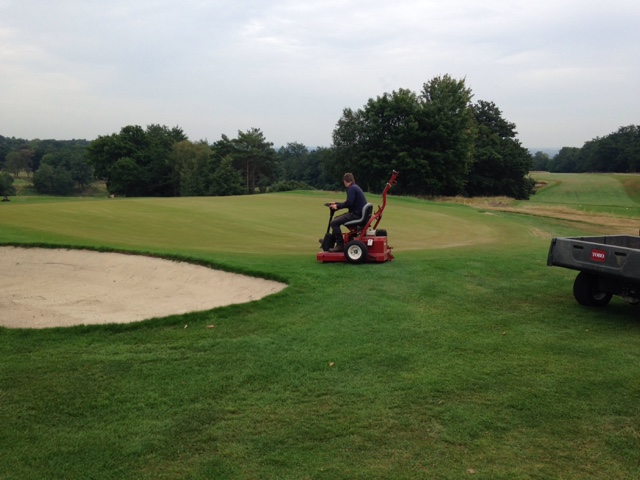Greens
A lot of work was completed on the greens last week with FOUR major works being carried out to each of them plus the top dressing (lots), over seeding and fertilising of the greens.
We started out with the verti drain. This has a deep aeration action (just like a huge fork in the garden). This is essential to link up the surface to the sub soil. It encourages the roots to go deep, increases oxygen.
Following the verti draining we applied our first topdressing and brushed it down into the verti drain holes. It's important we create drainage channels and try to improve our subsoil. Greens that were built back in the 1900's were designed to hold water as there was no irrigation until the 50's and proper irrigation systems weren't available until the 1970's. Add to this in the past little golf was played in the winter months meaning they could allow them to sit wet in the winter as long as they were okay for the summer.
Golf has changed now and players want to play 365 days a year. Greens like ours built in 1908 will require work to improve them for the winter months and this is something this type of work will improve year on year.
Next we hollow tined greens to 3 inches. This removed some of the thatch layer in the surface and removed some of the soil.
Soil exchange is so important especially as we head into the Autumn, it's important for us to increase the air in the soils by replacing compacted soils with new and replacing clays (our original soil type) with sand.
I know I ve said it before but clay soil is similar to flour in the way it's particles look and act and sand is like a bucket filled with gold balls. You can imagine the air created between the balls compared a bucket full of flour!
Once hollow cored we then collected the cores from the surface using core harvester (it does exactly what it says). The clear up team also had to hand shovel and blow the surfaces to leave them clean for our next process.
This time the cores were stock piled for future use as they break down (almost like a compost). We will be able to use these for many things in the future including landscaping projects.
Then we applied more sand (you will be noticing a pattern here I m sure)
Mean while on the greens were not working on another aeration practice was taking place. The air2g2 was hired in again and used to blast air into the greens under pressure (like mini fracking) to 12 inches below the surface. This helps to link up the surface all the way down to below 12 inches.
The next stage of the aeration process was a light scarification to -10mm using our own scarifiers. We decided to let the debris fly as there was obviously a lot of top dressing also coming out. Doing this also smooths the surface out quicker and allows us somewhere for the seed and fertiliser to sit once that process is carried out.
The debris was then blown from the surfaces using back pack blowers.
We then fertilised with C- Complex, this is an organic fertiliser which allows faster breakdown which results in minimal mower pick up and faster plant availability of nutrients, assuring a rapid response. In addition, the enhanced humic acid content helps to stimulate new root development.
We also over seeded the greens with All Bent grass species (which is more drought resistant and gets less disease) as part of our long term goal to increase our bent content in our greens. The germination will have been improved by the fertiliser as this has high carbon content which provides a food source for soil microbes.
And then (you guessed it) we applied another top dressing which took us well over our 200 tons for the year mark and brushed all of the fertiliser, seed and sand in.
It's worth noting here that all of the above has to be done 19 times over for each green including the putting green. There is so much extra work going into the greens. Over 100 extra man hours were required on top of normal hours and our pro core went through two sets of tines just to complete the greens this course maintenance week.
Aprons
The aprons became a challenge for us during this maintenance week.
The weather was getting hotter by the day and the ground harder. From the start we knew we wouldn't be able to verti drain them as the ground was to dry but we felt we could get a much needed hollow core in.
The picture below shows how much thatch we have in the top 35mm (looks like weetabix) plus the clay soil below.
This was mostly successful for 15 holes but 3 aprons had finally dried out to much in the heat of the week and on our last day we started to cause to much damage. This was entirely down to the dry conditions so we decided that we will wait to finish the last three holes when the conditions are more in our favour.
Above damage caused by the hollow corer. This has been repaired and we will now wait for better conditions.
So after a gruelling week in extreme temperatures I felt happy with operations we got done to the greens but a little bit upset we could get the aprons over the line. I have learnt that sometimes a little bit of patience is needed from our side to to achieve our goals and I know once the weather turns we will be able to finish what we had started.
The team were treated to our summer maintenance BBQ again with Chef Graham Hastie on the BBQ. This is a great way to thank the team for all there hard work and commitment during an extra long week.
As we finished the BBQ the diggers arrived for the bunker construction project.
From that point on we knew we would extremely busy for the next two months...
No rest for the wicked as they say!
See you out there
Matt
























































